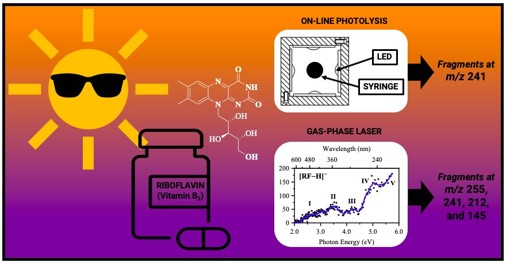The application of electrospray ionization mass spectrometry (ESI-MS) as a direct method for detecting reactive intermediates is a technique of developing importance in the routine monitoring of solution-phase reaction pathways. Here, we utilize a novel on-line photolysis ESI-MS approach to detect the photoproducts of riboflavin in aqueous solution under mildly alkaline conditions. Riboflavin is a constituent of many food products, so its breakdown processes are of wide interest. Our on-line photolysis setup allows for solution-phase photolysis to occur within a syringe using UVA LEDs, immediately prior to being introduced into the mass spectrometer via ESI. Gas-phase photofragmentation studies via laser-interfaced mass spectrometry of deprotonated riboflavin, [RFH], the dominant solution-phase species under the conditions of our study, are presented alongside the solution-phase photolysis. The results obtained illustrate the extent to which gas-phase photolysis methods can inform our understanding of the corresponding solution-phase photochemistry. We determine that the solution-phase photofragmentation observed for [RFH] closely mirrors the gas-phase photochemistry, with the m/z 241 ion being the only major condensed-phase photoproduct. Further gas-phase photoproducts are observed at m/z 255, 212, and 145. The value of exploring both the gas- and solution-phase photochemistry to characterize photochemical reactions is discussed.

